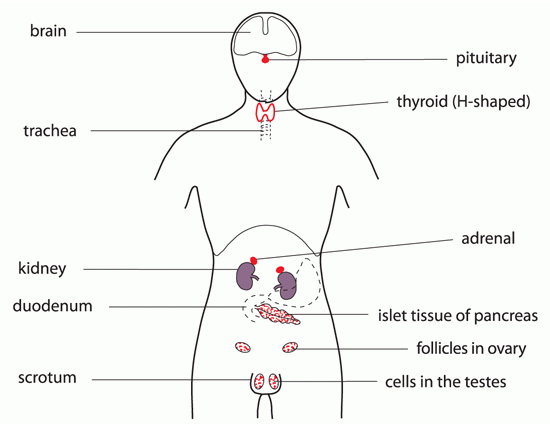Homeostasis
It is vital that the internal environment of the body is kept fairly constant. This is called homeostasis.
The different factors that need to be kept constant include:
Water - temperature - sugar levels -mineral content
Many of the mechanisms that are used for homeostasis involve hormones.
Hormones are chemical messengers that are carried in the blood stream. They are released by glands and pass to their target organ. Hormones take longer to have an effect than nerves but their responses usually last longer.
Many of these control mechanisms work by negative feedback. This means that if the levels change too much, a hormone is released and this brings the change back to the normal level.

Control of Blood Sugar
It is vital that the sugar or glucose level of the blood is kept constant. If it gets too low then cells will not have enough to use for respiration. If it is too high then glucose may start to pass out in the urine.
Insulin is the hormone that controls the level of glucose in the blood.
When glucose levels are too high, more insulin is made. The insulin converts excess glucose into glycogen to be stored in the liver.
People with diabetes do not produce enough insulin naturally. They need regular insulin injections in order to control the level of glucose in their blood. They also need to control their diet carefully.
Blood Glucose level too high?
- 1. Insulin injected by pancreas
- 2. Glucose absorbed by tissues
- 3. Glucose absorbed by liver
- 4. Blood glucose reduced
Blood Glucose level too low?
- 1. Insulin not injected by pancreas
- 2. Less glucose absorbed by tissues
- 3. Less glucose absorbed by liver
- 4. Blood glucose increased
Diabetes – This is a condition where people who suffer from this do not make insulin so it needs to be injected
This video explains how a diabetic controls blood sugar levels
Control of Body Temperature
It is important to keep our body temperature at about 37 °C. This is because it is the best temperature for enzymes to work. The blood temperature is monitored by the brain and if it varies from 37 °C, various changes are brought about.
When we feel too hot we need to lose heat faster, as our core body temperature is in danger of rising. We do this by:
- sweating – as water evaporates from our skin, it absorbs heat energy. This cools the skin and the body loses heat.
- vasodilation – blood capillaries near the skin surface get wider to allow more blood to flow near the surface. Because the blood is warmer than the air, it cools down and the body loses more heat.
- If the blood temperature gets too high it could lead to heat stroke and dehydration.
When we feel too cold we are in danger of losing heat too quickly and cooling down. This means we need to conserve our heat to maintain a constant 37 °C. We do this by:
- shivering – rapid contraction and relaxation of body muscles. This increases the rate of respiration and more energy is released as heat
- vasoconstriction – blood capillaries near the skin surface get narrower and this process reduces blood flow to the surface. The blood is diverted to deeper within the body to conserve heat.
- sweating less
Hypothermia occurs when the blood temperature gets too low. It can be fatal.
This video explains how the body keeps cool whilst exercising
Controlling Body Water
Too much water?
- 1. Hypothalamus (part of brain) detects too much water in blood
- 2. Pituitary gland releases less ADH
- 3. Kidneys absorb more water from blood
- 4. More water reaches bladder and is lost through urine
- 5. Blood water level returns to normal
Too little water?
- 1. Hypothalamus detects too little water in blood
- 2. Pituitary gland releases more ADH
- 3. Kidneys absorb less water from blood
- 4. Less water reaches bladder and is lost through urine
- 5. Blood water level returns to normal
This video explains how your kidneys control water content
